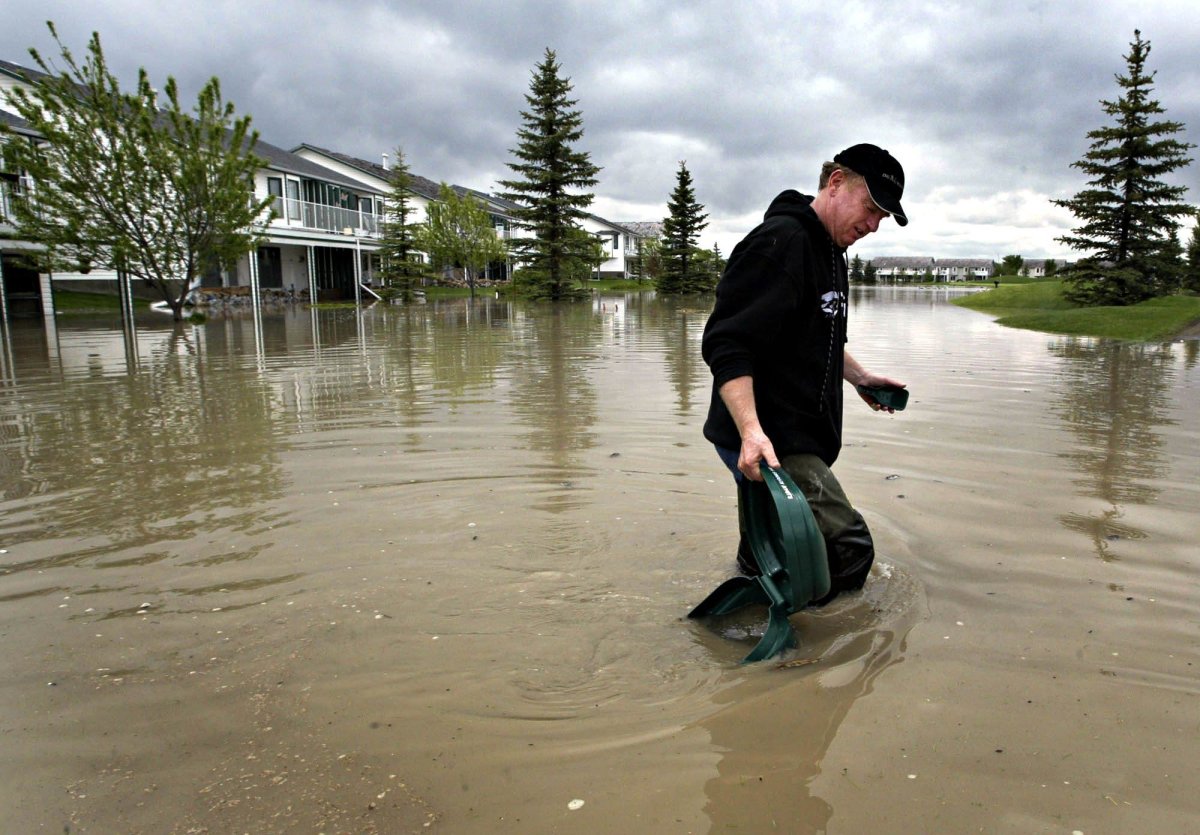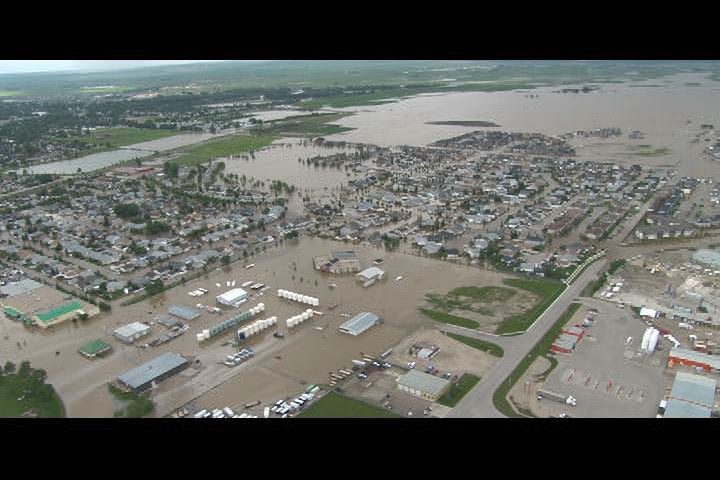WATCH: A montage of the Calgary flood, set to “Hell or High Water”

CALGARY- July 20 marks one month since the worst natural disaster in Calgary’s history—and it’s incredible how far the city has already come, as Calgarians band together to rebuild.
In the early hours of June 20, emergency officials were scrambling to finish building hastily erected berms, in hopes of saving homes from rapidly rising flood waters. But their best efforts were not enough, after both the Elbow and Bow rivers spilled their banks, drenching low-lying areas of the city.
Mayor Naheed Nenshi raced back from Ontario as mass evacuations got underway. At the height of the disaster, 100,000 people were forced from their homes, some with only minutes to get out. Power was shut off to many areas including parts of downtown, turning the bustling core into a ghost town.
THE AFTERMATH
The damage was staggering.
Basements and ground floor apartments in Mission bore the brunt of it, with flood waters damaging everything in their path—causing some people to lose absolutely everything. Multi-million dollar homes were destroyed in the areas of Roxboro, Rideau, Elbow Park and Bowness. Seniors in the East Village and Chinatown were forced out, and some residents of Sunnyside saw their homes flooded not once, but twice after another sudden storm hit them again just two weeks later.
- McLean accuses Calgary third-party advertiser of ‘whipping votes’ in favour of rezoning bylaw
- Canadian curler Chelsea Carey says don’t compare me to Jennifer Jones
- Firefighters battle blaze at vacant house in northwest Calgary
- 7 sent to hospital after carbon monoxide poisoning incident in northwest Calgary
“Global 1 was hovering above the Stanley Park area. I could see the outdoor pool building, but couldn’t figure out where the pool was,” remembers Global News anchor Gord Gillies. “As the helicopter zoomed in, I could see the top of the lifeguard chair poking up out of the water. That’s how high the water was.
“If I wasn’t looking at it, I wouldn’t have believed it.”
Calgary was not alone. A number of other towns and communities were severely impacted, including Canmore, Okotoks, the Siksika and Stoney Nakoda First Nations, Turner Valley, Black Diamond and High River.
Reporter Jill Croteau spent almost 16 hours in High River on day one of the floods.
“When night started to fall, the rescues still continued and we were live on the air with the dramatic scenes. I saw parents reunited with their children stranded at their day homes…it was a precious and heartwarming sight. My crew and I finished that first day emotionally exhausted but I couldn’t wait to get back at it the very next morning grateful for the chance to do my part in telling this incredible story.
“In the weeks after the waters subsided, photographer Nate Luit and I spent nearly all of our time covering High River. We now have a connection to that town that I never expected. I have hugged more people in High River in the last month compared to my entire career. I have seen grown men cry…lost and helpless and I have shed tears with them….wishing I had the right words to say. I have been so humbled to have met so many resilient people. I am in awe of their will to recover from something I can only hope I would have the strength to do. They have reminded me to never take anything for granted. It has been an intense month but an experience I feel lucky to have been a part of.”
Social media also played a huge role during the disaster, with emergency agencies like police, the city and the province relying on the media and Twitter to get the word out about warnings and evacuations.
“It was busy from the moment I walked into the newsroom at 5 a.m.,” says online reporter Melissa Ramsay. “Canmore was being evacuated due to flooding, and there were fears Calgary’s rivers could also swell. As time ticked by, more and more communities in southern Alberta were placed in a State of Emergency, and the severity of what was happening to our province became clear.
“Amidst the flurry of my fingers flying across my keyboard, I would gaze up from my computer every so often to watch our footage of flooded areas – viewing unbelievable images of the water’s destruction. I never could have guessed as I was driving into work that morning, singing along to the radio, what kind of day I was walking into. It is mornings like June 20th that make you realize how unpredictable life can be—but it’s the amazing spirit I witnessed in Calgary the following weeks that confirmed for me how proud I am to be an Albertan.”
THE CLEANUP
Veteran reporter David Boushy has seen a lot in his long career, but says even he was shocked by the events transpiring in front of him.
“Natural disasters like floods, happen to other people in other places. Or so I thought. And while the floods of June 2005 were big, I wasn’t expecting the magnitude of the 2013 floods. I was impressed by a lot of things, but two stand out: the EOC coordination of disaster services and the timely information/updates they provided, and how our news organization was able to respond to the crisis. I’m so proud of the people I work with.”
Some of Global Calgary’s staff were impacted by the disaster first hand, including Morning News co-host Leslie Horton who stayed on-air for 14 hours, despite her Bowness home being evacuated.
“As I was watching the rising water ravage roads and communities, my neighbours were texting me pictures of our neighbourhood—and the water inching towards my house,” she remembers. “During the evacuation Thursday night, I decided that the ‘stuff’ in our house didn’t matter, the people did, and if we were all safe the rest could be dealt with.
“I was surprised during those first few hours of our flood coverage at the notes of support and thanks that poured into the newsroom—we are the ones honored to be in a position to help. A couple of days post-flood, an ‘under the radar’ trip to my house showed no damage. Instead of taking a breath then, I headed through the ‘hood to Bow Crescent, and joined the clean-up effort. Along with so many others, I found strangers became friends, greetings like ‘how are you’, ‘how’s your house’, and ‘do you need anything’ became the norm.
“It seemed like Calgarians collectively decided that Mother Nature would not dampen our spirit, and we would stand side by side undaunted in the face of mud, muck, tears and devastation. The spirit in this city leaves me speechless. You had to live it to believe it. I am no longer a Vancouverite living in Calgary…I am honored to call myself a proud Calgarian.”
Those whose homes weren’t affected were also blown away by the outpouring of support from around the city, as thousands rushed to help with the massive cleanup.
“I was one of the lucky ones. My home was safe the day of the floods, yet I experienced an emotional roller coaster hearing the stories of others who lost so much,” says reporter Bindu Suri. “I felt the initial shock and sadness of the widespread flood devastation. Then, a sense of hope as I watched the countless volunteers re-define the word community.
“The majority of the stories I reported on during the flood came from the volunteers. We drove on silt covered streets and found dozens of volunteers sifting through garbage. It wasn’t depressing, in fact it was uplifting to see strangers helping strangers. I also visited a community kitchen full of even more volunteers. Within a few days they collectively cooked 6,000 meals for evacuee centres across Calgary. I was blown away with the need from those displaced and the generosity from the public.
“It was inspiring to see people not just lending a hand out, but a hand ‘up’ getting people back on their feet. It was a huge step forward towards a rebuilding effort that will likely last many years to come.”
WATCH: A montage of how Global News covered the Alberta flood
A CITY, TRANSFORMED
Reporter Mia Sosiak, who hails from Winnipeg, adds that watching Calgary’s transformation has changed her perception of the city.
“When I moved to YYC, I couldn’t help comparing the two cities. Sure, I knew Calgarians give lots of money and the volunteering rate is high. But this city just seemed so much bigger and more indifferent. It seemed like no one even knew their neighbours and everyone just worked too much and stuck to themselves. Wow, has my sense of who and what Calgarians are all about switched.
“Over and over in the past month we have seen examples of the real personality and spirit of this city. How we reach out and truly take care of each other. The citizen rescuers, the emergency workers who worked endlessly, throngs of volunteers saying ‘I just want to be put to work,’ the devastated flood victim who returned his donated cleaning kit when he was finished, because he thought another victim might be able to use it too. And many, many more examples.
“I am so proud to be ‘from’ Calgary.”
Just two weeks after the flood, the Calgary Stampede managed to pull off the Greatest Outdoor Show on Earth—despite Stampede Park and the Saddledome at one point looking more like a lake than a world-class venue. The rivers have now receded and returned to their glorious blue and green colours—a vast difference from the muddy brown waters that washed over the city. The debris has been cleared, roads restored and Mayor Nenshi has finally gotten his nap.
The one thing that will forever remain is the community that was built during the devastation, and the memories of complete strangers rushing to help those hit hardest and asking nothing in return.
With all of this progress in just one month, it’s incredible to think of where we might be this time next year.











































Comments